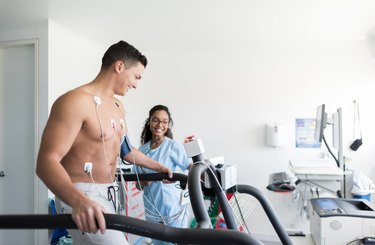
A treadmill test, also known as a cardiac stress test or an exercise stress test, is a fairly common medical test that can show how efficiently your heart is working. Though it can feel rigorous, it's not painful and can warn of heart problems.
For example, the Mayo Clinic says that heart stress test results are helpful for identifying coronary artery disease and heart rhythm problems. The American Heart Association (AHA) also notes that a treadmill test can help predict your risk for serious heart-related events, like a heart attack, or check how well a heart procedure designed to improve circulation is working.
Video of the Day
Video of the Day
Your results can also guide your doctor in recommending the appropriate type of exercise for you based on your specific capabilities.
"Exercise stress tests, such as a treadmill test, help physicians monitor your heart health by making your body work," says Sanjay Shetty, MD, division chair of cardiology for AtlantiCare in southern New Jersey. "During the test, you will be hooked up to an electrocardiography machine, which will monitor your heart rate, blood pressure and breathing."
Read more: What Are METs on a Treadmill?
How a Treadmill Test Works
The exact nature of a treadmill test may vary depending on the doctor administering the test, but for the most part, the steps are the same. First, sensors will be placed at key spots on your body and connected to the electrocardiography machine, says Mayo Clinic. It records your heart's electrical rhythms. Your medical provider will also monitor you blood pressure, says Harvard Health Publishing. Next, you'll start to walk on the treadmill.
Over time, says AHA, the treadmill's speed or elevation setting may be increased, with continued monitoring of your body's functions. You may be asked to breathe into a tube to measure respiration during the test as well. Once the test is complete, a final check of your health metrics may take place while you rest.
Though you might huff and puff during the test, it's not dangerous and it can be stopped at any point that it becomes difficult.
Blood Pressure During Treadmill Tests
When you perform a treadmill test, Dr. Shetty says it's normal for blood pressure to become somewhat elevated. However, the line between normal blood pressure elevation and extreme elevation can sometimes be difficult to determine. This can make diagnosis challenging based on blood pressure readings alone during the exercise test.
"According to U.S. guidelines, in a stress test, a normal blood pressure should not exceed 210 in men or 190 in women," says Dr. Shetty. "Of course, what is considered normal can differ from person to person. It is important to consult with your physician about your blood pressure levels and what they mean for your body."
According to Stanford Medicine, high blood pressure during a treadmill test may indicate a potential heart problem. On the other hand, blood pressure can also increase in healthy people as the intensity goes up.
In fact, people who are more fit may actually have higher blood pressure during the test. That's because they tend to reach higher treadmill speeds or elevations during the test, which in turn naturally raises blood pressure as they continue to exercise. This could present a conundrum for doctors trying to interpret the results of their exercise stress test.
"In many cases, high blood pressure in a stress test can be an indicator of heart disease, but not every time," says Dr. Shetty. "In healthy people, systolic blood pressure can easily exceed 160 mm Hg with exercise. This is because your body is working harder to deliver oxygen to your muscles."
Ultimately, Dr. Shetty notes that your blood pressure during the treadmill test is just one piece of the puzzle in diagnosing a potential heart problem.
- Mayo Clinic: “Stress Test”
- American Heart Association: “Exercise Stress Test”
- Sanjay Shetty, MD, division chair, cardiology, AtlantiCare, southern New Jersey
- Stanford Medicine: “Exercise Stress Test Results Often Misinterpreted as Bad News”
- Harvard Health Publishing: "Cardiac Exercise Stress Testing: What It Can and Cannot Tell You"
Is this an emergency? If you are experiencing serious medical symptoms, please see the National Library of Medicine’s list of signs you need emergency medical attention or call 911.